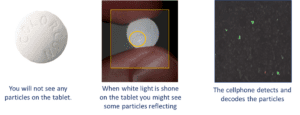
What are smart medicines and why are they used?
Smart medicines are digitized forms of traditional medicines. They are created by adding a target to a medicine that can be detected by a sensor. The benefits of smart medicines include:
- Keeping patients safe – making sure patients are taking the right medications and that the medications are authentic.
- Improving health outcomes – helping patients to take their medications in a timely fashion.
How does the TruTag Smart Medicine Solution work?

- We take an existing tablet or capsule and add microparticles to the surface of the medicine.
- These microscopic particles are made of silicon dioxide, a material that is commonly used in pharmaceutical and food production.
- During manufacture, we create pores in the particles.
- These particles are largely invisible until they are illuminated by light. When this occurs, the light reflects off the pores at a specific color.
- Our smartphone application works by turning on the flashlight from the cell phone and utilizing the camera and our algorithms to detect and decode the particles.

Do the TruTags impact the medicine in any way?
- No. Microparticles are added in minute quantities (typically 0.01% of tablet weight) in the external coating and do not impact the bioavailability of the medicine.
Is it difficult to transition a medicine to a smart medicine?
Our Smart Medicine solution is easy to adopt from an economic, regulatory, and operational perspective.
- Economic – our solution only costs a small fraction of a cent per unit to adopt.
- Regulatory – our particles are GRAS (Generally Recognized As Safe). The quantities that we apply require only a small annual reportable change.
- Operational – our particles are applied via coatings and inks without the need for business process reengineering.
